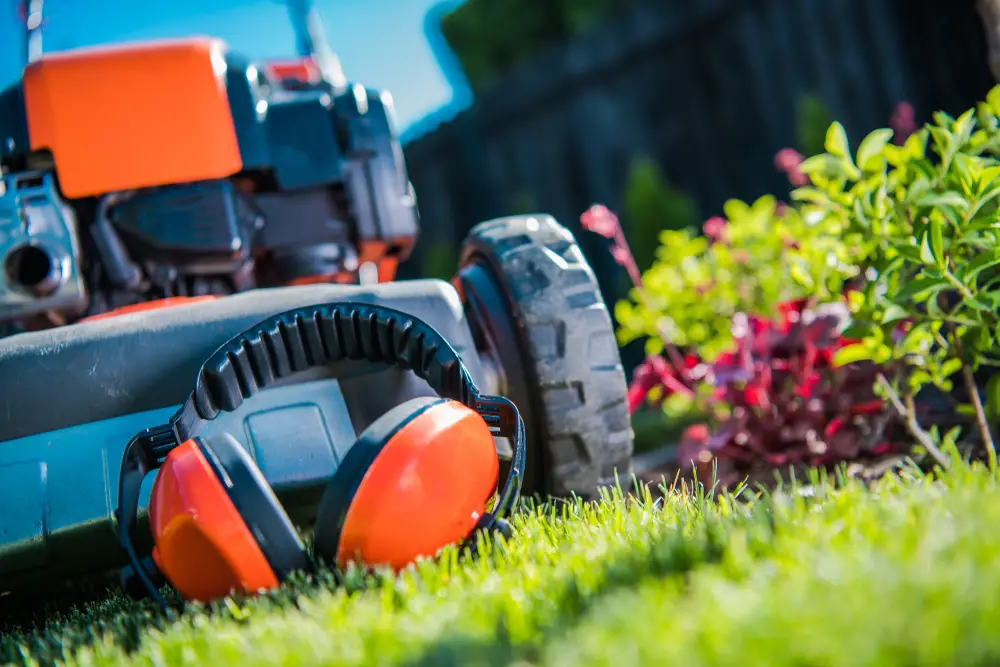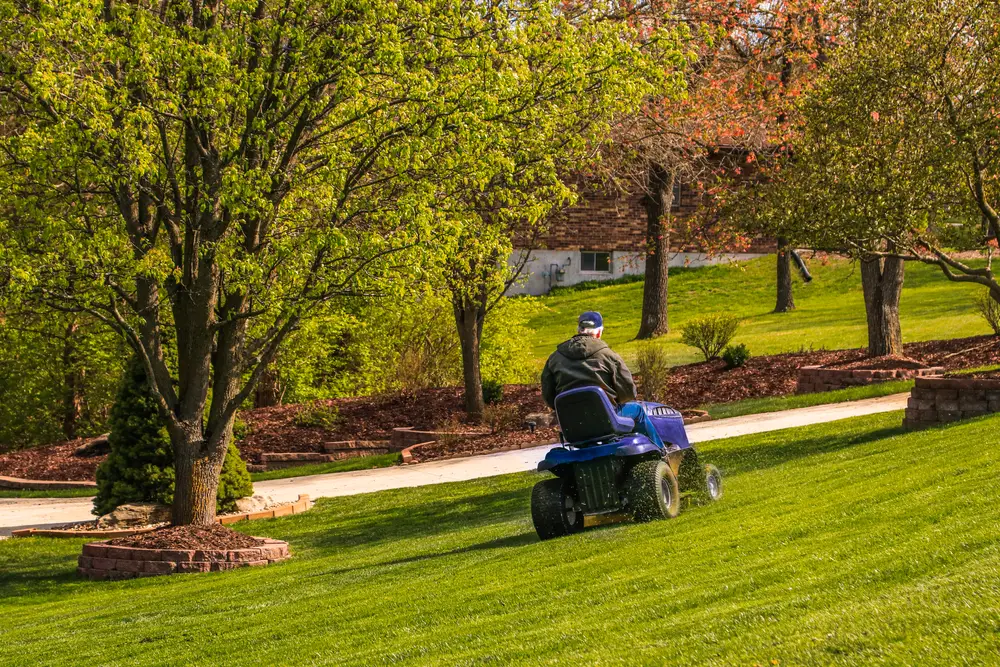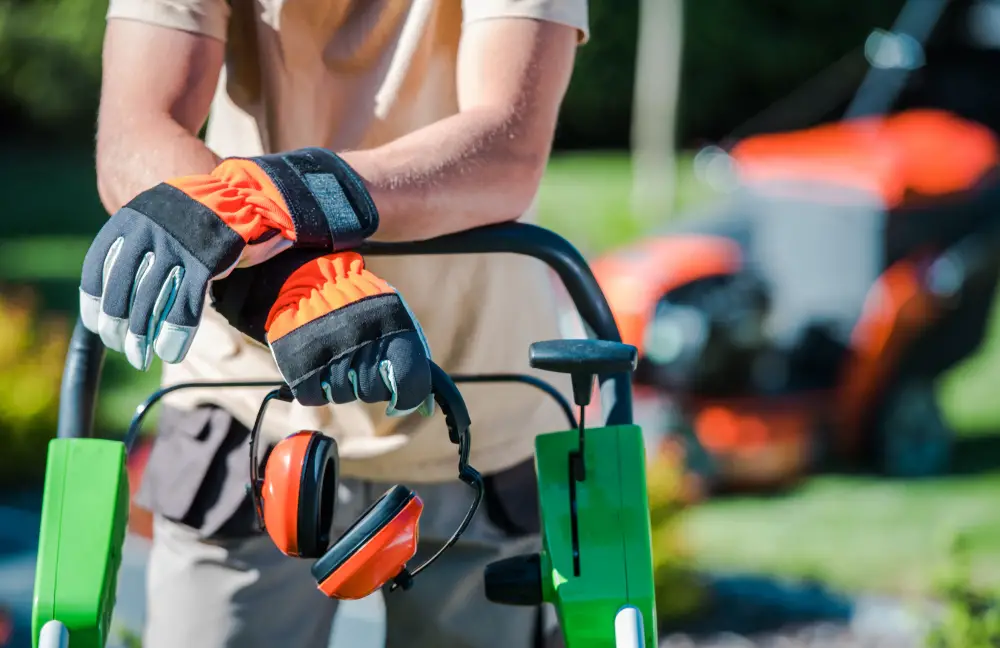Mowing your lawn can be a relaxing and enjoyable activity. That means mowing your lawn safely every time. To help, here are our tips to safely mow your lawn.
Do the following to safely mow your lawn:
- Pick the right lawn mower and other equipment
- Perform routine maintenance
- Clear debris
- Check for potential causes of injury
- Move pets and children to a safe area
- Trim edges first
- Wear protective gear
- Hydrate and stay cool
- Properly handle obstacles and unusual terrain
In this content you’ll learn:
How To Safely Mow Your Lawn

Safely mowing your lawn means taking many essential steps before mowing, during, and after. Staying consistent with these tasks means consistently staying safe.
Let’s begin with what to do before mowing.
Before Mowing
There are several necessary steps you’ll need to take before mowing. They may seem like a lot of extra work, but they help keep you safe. In addition, the more you do them, the more they’ll become routine.
Pick The Right Lawn Mower And Other Lawn Care Equipment
Several types of lawn mowers (and other lawn care equipment) exist. Knowing what they are and what they’re designed to do allows you to make an informed choice. Doing this not only gives you a beautiful lawn and an easy time maintaining it, but it also keeps you safe.
Perform Routine Maintenance
For best results, always maintain your equipment, inspecting your lawn mower before each use. Primarily, check your oil, gas, and blades.
Check Oil And Gas
Look and see that the oil is topped up and the gas tank is full with the gas cap screwed tightly.
Check The Blades
Check that your blades are sharp and in good condition. Otherwise, the lawn mower will need help to cut through thick grass. Dull blades will tear the grass instead of providing a clean cut, which leaves it vulnerable to diseases and pests.
If you don’t have the tools to sharpen your blades, take them to your lawn mower dealer for sharpening at the start of the season.
Clear Debris Or Obstacles
Before you start mowing, walk around the lawn and remove any debris or obstacles that can damage your lawn mower blades. Take note of any low-hanging branches and remove them if they are dangerous. Also, remove any toys or objects that are potential projectiles that could injure you or someone standing nearby.
Check For Other Potential Causes Of Injury
Before mowing, inspect fences and walls, checking that no protruding nails or brackets may snag on your clothing or skin as you move them past them. You’ll also want to check for low-hanging branches and washing lines. Doing this is particularly important for using a stand-on or sit-on lawn mower.
Some reeds and grasses are also likely to cause lacerations if you accidentally brush against them as you pass by. Look for thorn trees or plants like cacti that can cause serious injury, especially to your face and eyes.
Move Pets And Children To A Safe Area
If pets or children are on the lawn, move them to a safe area before mowing. It’s better to be safe than sorry.
Trim Your Lawn’s Edges And Borders
Preparing your lawn for mowing is also an ideal time to trim the lawn edges and borders so that you have a clear idea of where the limits of your yard are. Overgrown borders may bog down your lawn mower, potentially damaging the blades. The blades will also create an ugly divot in your lawn.
After inspecting the lawn, it’s time to don your protective gear.
Wear Protective Gear
You should always wear adequate protective gear, including safety glasses, closed-toe shoes, and ear protection. This will safeguard you from hazards such as flying debris and excessive noise.
Don’t forget to wear a hat when cutting grass in the summer months. Heat stroke and dehydration can cause you to make mistakes that might end with losing a finger or worse.
While Mowing
There are also several essential safety steps to take while mowing as well. This begins with knowing when not to mow.
Know When Not To Mow
Try to avoid cutting the grass when it is wet, as you could potentially damage it. Wet grass can make your lawn mower lose traction, which is a shock hazard if you use an electric lawn mower.
Hydrate And Stay Cool
Wear a hat while outside (before, during, and after mowing), as you risk getting sunburn or sunstroke while mowing your lawn, especially in mid-summer. Also, don’t forget to keep water handy, as you can quickly dehydrate without being aware of it. When your mouth becomes dry, your body is already in the early stages of dehydration.
Stay Aware
After performing all pre-mowing safety tasks, it can be tempting to ease up. Don’t assume there’s no danger. No one’s perfect, and unexpected issues can arise. Staying aware helps prevent them from causing safety hazards.
After Mowing
To avoid damaging your lawn mower or potentially impacting debris on the lawn, remove grass clippings and any other debris after you’ve finished mowing. Clippings may hide large sticks or pieces of metal or wire.
If your lawn mower blades hit these obstacles the next time you mow, they can cause damage to the cutting edges. The blades may also fling debris from under the lawn mower, causing cuts and abrasions.
You also don’t want clippings on your lawn, as they can stifle grass blade growth or damage the root system.
Mowing Tips For Challenging Areas

Rarely are lawns on altogether even ground and without difficult areas to mow. Knowing how to navigate these areas properly is integral to mowing your lawn safely. This begins with learning how to handle slopes and inclines.
Handling Slopes And Inclines
When handling slopes and inclines, choose a lawn mower with a low center of gravity and wide rear tires. This will give you better slope stability and help prevent the lawn mower from toppling or sliding.
It is best to mow across the slope in your lawn rather than up and down. This reduces the risk of tipping over.
With self-propelled lawn mowers and riding lawn mowers, be cautious of tackling excessively steep slopes. Check the manual for how to engage the differential lock feature, if your lawn mower has it, for improved traction.
Mowing Around Lawn Features
When mowing around trees, flowerbeds, and other garden features, use a string trimmer or edger to carefully trim grass around them to avoid damaging the bark or plants. You can also create a buffer zone around the base of trees and plants by hand-trimming the grass.
Handling Bumpy Ground
Use a lawn mower with larger wheels or pneumatic tires if the ground is bumpy. These provide better traction and maneuverability on uneven terrain. Alternatively, you can level out the bumps by filling in the low spots with soil first, leveling the surface before you mow.
Conclusion: How To Safely Mow Your Lawn
Safely mowing your lawn boils down to knowing the essential steps and staying consistent. Doing so dramatically improves your chances of staying safe while mowing the lawn.
So, what do you think of our tips? Got any of your own? Let us know in the comments below!


I have a Poulan Pro model PB195A46LT riding mower. I have tired to get parts for this mower even through the local dealer repair shop. They have advised me they can’t get parts through the manufacture.
I have read a lot of praise by the manufacture, but not impressed if I can’t find a direct contact to them or if they make the part required. I was told that the only was to get the plastic part I needed was to buy the complete transaxle assembly.
Trying to find an old non operational Poulan Pro for parts, any one have any idea’s or how to contact the manufacture direct?
Than ks
Please contact Poulan pro customers services for All Inquiries: 1.800.849.1297
where can i find pb301 riding lawn mower